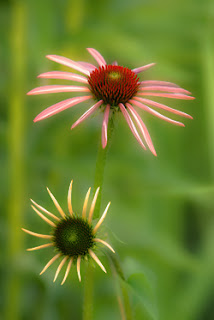Not too long ago I found myself attempting to photograph an area in low light without a tripod…The results were predictable and indeed the shots turned out rather mediocre at best. Most of them were blurred to a degree even with the anti shake turned on…it was a combination of too little light, too long of a focal length, too slow of a shutter speed, and too shaky of a hand hold…a lethal combination for clear pictures.
Most of my serious photography is always shot from a tripod using a cable shutter release even in good light. There are times I shoot by hand, but usually only when using a tripod may not be practical and only when there is adequate light. I’ve muffed a lot of great photo opportunities because of hand held shaking.
Most lenses today come with anti shake stabilization technology and in the Sony Alpha series of cameras internal anti shake within the camera is used. This technology does improve on the hand shake blurring problem. Even so, that technology can only help so much and that is why investing in a solid tripod is so important.
Because we as photographers chase around searching for that quality light situation, we often find ourselves photographing in low light which offers the best mood generating opportunities. The very nature of low light requires relatively slow shutter speeds and there in is the problem. A tripod allows for solid placement of the camera and a steady platform.
Although I’m not trying to promote any particular brand or style, the one thing to look for in a tripod is sturdiness. Avoid those light weight point and shoot models. Although they tend to work okay for light weight video equipment, they will not perform very well with a full size camera and lens combo and are just not strong enough or sturdy enough. Ask yourself…Will it hold up well in wind and with a heavy lens attached? A person can easily drop several hundred dollars on a tripod and even more with a high tech ballhead camera mount. Although carbon fiber may be the latest and greatest in strength and light weight functionality, my budget doesn’t allow for such high dollar luxuries. Instead I’ve opted for something a bit more affordable and purchased a surprisingly sturdy tripod for around $90.00. It does not have one of those fancy ball mounts on top. Instead it has a simple tilt mount…a bit more cumbersome, but functional. When I shoot with my 50 to 500 lens, the tilt mount doesn’t even come into play as the lens allows for rotation while locked down on the mount.
With few exceptions this tripod has done everything I’ve asked of it. It’s light enough so I can tote it with camera attached over my shoulder and indeed I have done so on hikes across the Prairie or over hill and dale on various other hikes and canoe trips. It has quick release collapsible legs that allows for easy and quick setup on any level of terrain, and I can quickly and easily rotate or tilt the camera in any direction I need. I’ve also used it as a third leg when crossing streams or slippery terrain. It will extend out to over six feet in height or collapse down to about two feet. I’d prefer it would collapse down lower, but I’ve been able to get most of the low angle shots I’ve needed with it.
I’d recommend using a cable shutter release or remote release if your camera allows for one. Even sturdy tripods can be affected by the action of pressing the shutter release button. In a pinch you can use the camera’s self timer…but this can be a bit slow and cumbersome to do all the time especially when timing is important. Also, in most cases you will want to turn off the camera or lens stabilization mechanism when using a tripod as it can often become confused thinking that if it’s turned on, its suppose to actually do something and end up having the opposite effect. Although I’ve shot with the stabilization in both the on and off mode when using a tripod, I’ve personally not seen much difference in the results. The only time I will purposely turn it on when using a tripod is on windy day. That long lens and sunshade tend to catch the wind and can produce wind generated vibrations…enough anyway to warrant using the stabilization function.
Over the years I’ve grown more accustomed to using a tripod and have experienced firsthand the positive benefits they provide. It’s as much a part of my equipment list as the camera and lenses…and the third leg that it provides certainly makes for a steadier platform from which to shoot or to cross a stream.
Keith







































